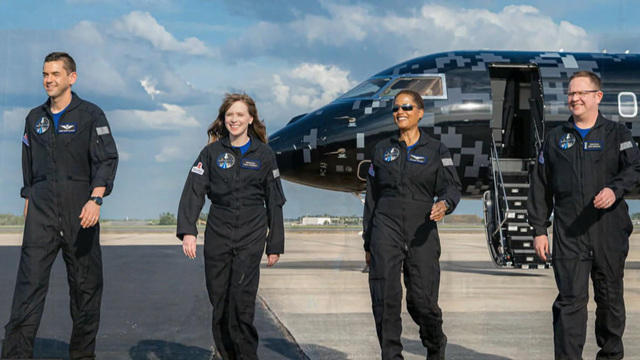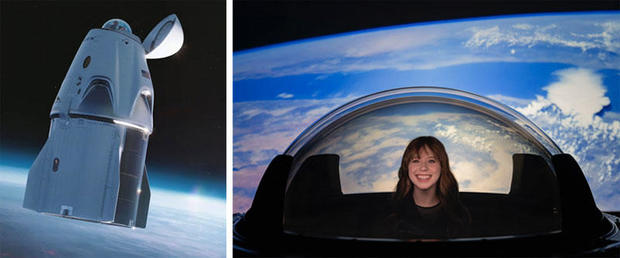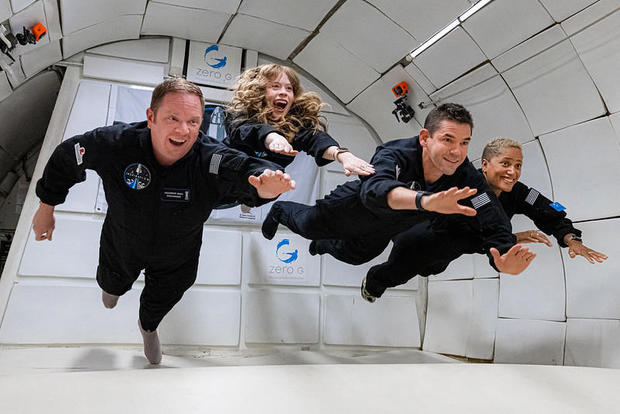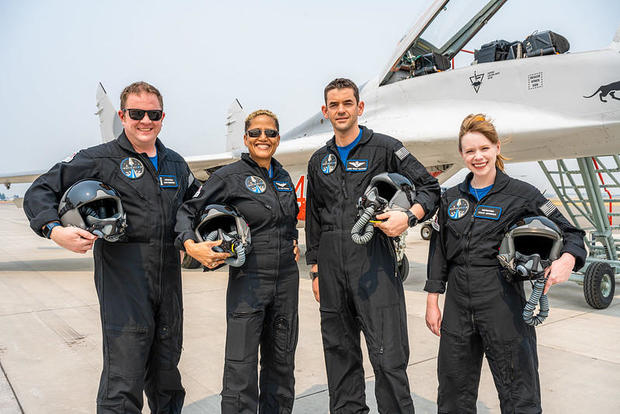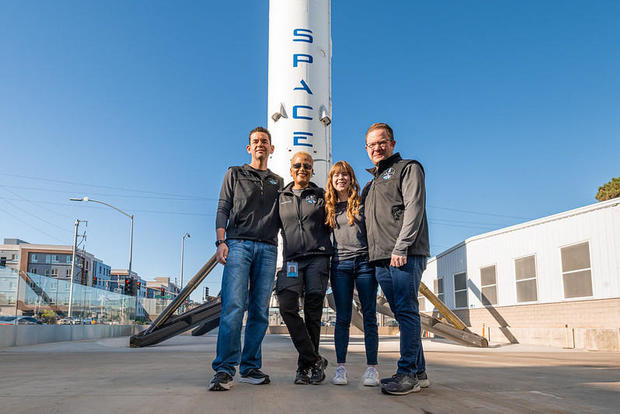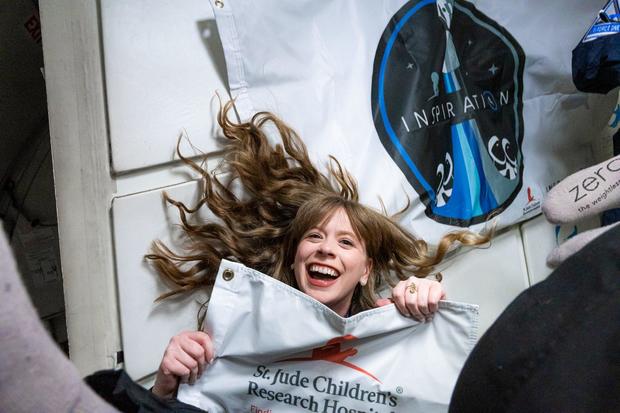▶ Watch Video: SpaceX to launch four American civilians on historic, three-day voyage around Earth
An all-civilian, non-astronaut crew, including a childhood cancer survivor, is ready for blastoff this week on a history-making SpaceX flight. Launch is scheduled for Wednesday evening for the first fully commercial, non-government flight to orbit, a charity-driven mission proponents say will open the door for “everyday people” to fly in space.
While billionaires Richard Branson and Jeff Bezos made headlines earlier this summer spending a few minutes in weightlessness during up-and-down sub-orbital flights to space, the Inspiration4 crew will spend three days orbiting the Earth aboard a SpaceX Crew Dragon capsule.
And not just any orbit. A SpaceX Falcon 9 rocket will boost the Crew Dragon Resilience into a planned 360-mile-high orbit, 100 miles above the International Space Station, higher than anyone has flown since the final shuttle visit to the Hubble Space Telescope in 2009.
From that lofty perch, the civilian crew of four will enjoy unrivaled 360-degree views of Earth and deep space through a clear, custom-built dome in the nose of the capsule.
“It is the first time that a global superpower hasn’t sent people up into orbital space,” Jared Isaacman, the tech billionaire who’s paying for the Inspiration4 mission, said when introducing his crew in March. “And I think that should send a message of all the things to come, right?
“Someday in the future, 50, 100 years from now, you’re going to have a lunar base, you’re going to probably have some sort of a Martian colony. But you have to start somewhere. And I think when this mission is complete, people are going to look at it and say it was the first time everyday people could go to space.”
Regardless of the hype, the flight does, in fact, mark an historic milestone. Whether it’s a harbinger of things to come is not yet known, but as Isaacman says, it’s at least a step in the direction of opening up the high frontier to visits by non-professionals.
The Inspiration4 crew is expected to blast off, weather permitting, Wednesday evening from launch complex 39A at the Kennedy Space Center, the same pad used for Apollo moon missions. The exact launch time will be announced after SpaceX managers evaluate near-term forecasts for launch and landing weather.
The Crew Dragon flight is expected to last about three days, ending with a fiery plunge back to Earth and a parachute-assisted splashdown in the Atlantic Ocean east of Cape Canaveral or, depending on the weather, the Gulf of Mexico.
Along the way, Isaacman and his crewmates will collect medical data and carry out life science experiments. The high-profile initiative is intended to shine light on, and raise money for, St. Jude Children’s Research Hospital in Memphis.
Crew members offer “powerful and inspiring story”
Isaacman, the 38-year-old founder of Shift4 Payments, is believed to have paid SpaceX in the neighborhood of $200 million for the ride to orbit for him and three crewmates, who were chosen as part of his personal St. Jude charity drive.
A renaissance man of sorts, Isaacman dropped out of high school at age 16 to develop what became Shift4 Payments, a company that processes payments for more than 200,000 restaurants and other retail outlets. He also is an accomplished aviator, owning a fleet of fighter jets used in part to train military pilots.
The Guardian, in a review of a Netflix docu-series about the mission, described Isaacman as “that rarest of beasts — a genuinely personable billionaire.”
He will be joined aboard the Crew Dragon by Sian Proctor, a 51-year-old science teacher, one-time astronaut candidate, private pilot and artist; aerospace engineer Chris Sembroski; and Hayley Arceneaux, at 29 the youngest person to fly in orbit.
Treated for bone cancer at St. Jude when she was 10 years old, Arceneaux is now a physician assistant at the famed research center. She was suggested by St. Jude and chosen by Isaacman to represent one of the mission’s four guiding principles: “Hope.”
“Since I joined the crew … I’ve had so many opportunities to share my story and to inspire people in ways I never imagined possible,” she said. “I’ve heard from many families who are struggling with their own cancer journeys, and I’ve gotten to share my story with kids who are going through the exact same thing that I went through 19 years ago. I tell them to never lose hope.
“It’s an incredible honor to be part of this Inspiration4 mission,” she said when Isaacman introduced her to the media. “While we have a really fun adventure ahead of us, I know that we’re going to do some incredible work back here on Earth.”
Proctor and Sembroski were chosen as part of a sweepstakes-type contest. Proctor was selected to represent “prosperity” after using Shift4 Payments technology to promote sales of her art and poetry, posting a Twitter video that was viewed more than 70,000 times.
Sembroski entered the sweepstakes for the “generosity” seat on a whim, not thinking he had a realistic chance of winning. He didn’t even tell his wife, Erin, he had applied. And he was right. He didn’t win. But the person who did, a friend he knew at Embry-Riddle Aeronautical University, declined the seat and offered it to Sembroski.
A rocket enthusiast who once attended Space Camp near the Kennedy Space Center, Sembroski said the flight offers “an incredible opportunity … to inspire more people to share their talents and gifts with the world and show kindness to one another and be generous with each other. That’s the message I hope to bring back.”
Isaacman, taking the “leadership” position, will serve as mission commander. On top of what he paid SpaceX to charter the Inspiration4 mission, he said he would donate $100 million to St. Jude.
“Why are we doing this? To kick off what hopefully is the most successful fundraising and awareness campaign in history,” Isaacman said of the flight. “If we are going to eventually live in a world where everybody is capable of going out and journeying amongst the stars, then we better fight childhood cancer along the way.”
His crewmates were selected to highlight “the good we’re trying to do with the mission.”
“Every person who’s going to join this mission has to be able to deliver a very powerful and inspiring story in their own right,” Isaacman said.
The Branson and Bezos flights prompted criticism in some quarters about “billionaire joyrides to space.” But Isaacman and SpaceX founder Elon Musk insist that’s not the case with Inspiration4.
“This is a stepping stone on the way towards providing access to space for all,” Musk told reporters when the flight was announced. “Things necessarily start off real expensive, because it’s new technology at low volume, low production rates. And so we actually need people who are willing and able to pay the high prices initially in order to make it affordable, long term, for everyone.”
Isaacman announced the flight on February 1 and revealed Arceneaux’s name on February 22. Proctor and Sembroski were named on March 30.
Since then, the crew has spent a whirlwind five-and-a-half months preparing for the flight, studying mission plans, training in a SpaceX simulator, undergoing centrifuge runs to familiarize them with the accelerations of spaceflight and taking rides in Isaacman’s fighter jets. They even went mountain climbing together as a team-building exercise.
And now, it’s time to fly.
Some flight details kept in the dark
Unlike NASA missions, which are managed by a federal agency required by law to operate in the open, SpaceX is a private company and mission details are provided at the discretion of the rocket builder and Inspiration4.
Despite the historic nature of the flight, details about the Crew Dragon’s ascent trajectory, post-launch emergency procedures, crew rescue scenarios, the re-entry timeline and other details routinely provided in advance by NASA were not immediately available from SpacrX.
But the Netflix documentary, “Countdown: Inspiration4 Mission to Space,” filled in at least some of the blanks, and the crew’s Twitter accounts have provided additional insights.
While the Falcon 9 will take off from the Kennedy Space Center, launch complex 39A is leased by SpaceX, which is responsible for its operation. NASA will provide on-site security and agency personnel will support launch pad rescue operations if needed, but SpaceX is solely responsible for preparing and launching the Falcon 9 and Crew Dragon.
As a result, Isaacman and his crewmates will don their custom SpaceX pressure suits in a company facility, not in NASA’s traditional crew quarters, before being escorted to the rocket. NASA is expected to stream SpaceX’s launch coverage, but the agency will play no other role in the webcast or the mission.
SpaceX will be solely responsible for the decision to proceed with launch based on the the rocket’s health, weather at the launch site and weather conditions along the capsule’s trajectory where the crew could be forced to make an emergency landing in a launch abort. Launch also will require a good forecast for the normal end-of-mission landing zone.
The countdown will be virtually identical to the one SpaceX uses when launching astronauts to the space station for NASA.
Isaacman and his crewmates will begin strapping in about three hours before launch. Propellants will be loaded starting at T-minus 35 minutes and if all goes well, the Falcon 9’s nine first-stage engines will ignite and throttle up to 1.7 million pounds of thrust for liftoff.
Even though the crew will not be visiting the International Space Station, they will follow the same trajectory NASA astronauts use, taking off on a northeasterly path paralleling the East Coast, one tilted 51.6 degrees to the equator.
The first stage, making its third flight, will propel the ship out of the dense lower atmosphere. The single engine powering the Falcon 9’s second stage then will take over while the first stage heads for landing on an off-shore droneship.
For space station rendezvous missions, the Crew Dragon separates from the second stage about 12 minutes after liftoff. A few minutes later, the capsule’s nose cap rotates open to uncover a complex docking mechanism used to attach the ship to the space station.
For the Inspiration4 mission, SpaceX removed the docking mechanism and replaced it with a multi-layer plexiglass dome, providing room for two crew members at a time to poke their heads out of the capsule for an unimpeded 360-degree view.
Space motion sickness and other risks
One potential downside is that one-third to half of astronauts who fly in space experience some form of space motion sickness, or SMS, brought on by zero-gravity fluid shifts toward the upper body and related neuro-vestibular issues.
Symptoms can include nausea, loss of appetite, headaches and, in severe cases experienced by 10% to 20% of those who fly in space, the sudden onset of “projectile vomiting.”
Jonathan Clark, a former space shuttle flight surgeon now at the Baylor College of Medicine’s Center for Space Medicine, said it typically takes two to three days for astronauts to complete their adaptation to weightlessness, at which point the unpleasant symptoms taper off.
But any Inspiration4 crew members who suffer motion sickness will face the prospect of returning to Earth’s gravity field just as they are getting adjusted to weightlessness, a transition that can cause additional problems.
There is no way to predict who will experience SMS; test pilots are just as susceptible as rookies with no flight experience.
“The irony of it is, just because you never had any kind of terrestrial-based motion sickness, or even air sickness in an airplane, doesn’t mean you won’t get space motion sickness,” Clark said. “I’ve seen the toughest astronauts fairly significantly affected.”
Statistically, he said, one or two of the Inspiration4 crew members will not have any symptoms and any who do likely will have relatively mild cases. But the other extreme is possible. Arceneaux, a physician assistant, presumably would be prepared to administer medication as needed.
Any motion sickness aside, the crew will still face what many would consider a relatively high-risk endeavor.
Professional astronauts are paid to fly in space and receive years of training before they ever get to launch. They are much more aware of the risk to life and limb than any outsider, working in a culture that has experienced fatal accidents in all phases of flight: on the launch pad, during the climb to space and during re-entry.
“None of the crew members have expressed any, like, direct fear,” Isaacman told Netflix. “But I do think that there might be concerns in other ways, like for family, like hey, I know the risk I’m taking, I’m not entirely sure my family (knows) fully the risks that they’re taking.”
Isaacman’s wife, Monica, put it like this to Netflix: “It’s weird, like now that we’re getting closer to it, you start dreaming about the stuff, like good and bad, right? Like you start thinking about what could happen and the risks that are involved. I’m trying to be excited for him and show him how proud I am. But you have your good days and you have your bad days.”
SpaceX’s track record
Going into the Inspiration 4 flight, SpaceX had launched 124 Falcon 9 rockets, all of them successful except one that exploded during a 2015 cargo launch to the International Space Station. Since then, the company has launched 109 successful flights in a row.
Crew Dragon capsules have been successfully launched four times, three of them carrying astronaut crews on problem-free flights to and from to the International Space Station.
Adding to the comfort level, the Crew Dragon features a flight-tested “full-envelope” abort system that includes powerful rocket motors and sophisticated fault-detection software to instantly propel the capsule away from a malfunctioning booster at any point from the launch pad to space.
But depending on where launch abort occurred, the crew could end up in the water anywhere along a trajectory stretching from Cape Canaveral to the North Atlantic Ocean.
For NASA space station launches, Air Force Detachment 3 personnel stationed at nearby Patrick Space Force Base and in Charleston, South Carolina, are on standby to rescue a downed crew anywhere along its trajectory, with the goal of reaching a capsule within 24 hours in a worst-case scenario.
For emergency landings closer to Florida, the team can cut that down to six hours or less. The Air Force also station’s a team in Hawaii just in case a crew is forced to make an unplanned descent to the Pacific Ocean at some point during their mission.
It’s not known what plans SpaceX might have in place to rescue the Inspiration4 crew if an abort or unplanned landing should happen. But the capsule is equipped with survival gear, including a life raft, radios and homing beacons, to keep a crew safe until Coast Guard or other rescue teams arrive.
SpaceX’s ability to launch private space missions is rooted in NASA’s drive to encourage development of commercial spacecraft to ferry astronauts to and from the International Space Station, ending the agency’s sole reliance on Russia for post-shuttle space transportation.
In 2014, after a series of competitions, NASA announced that Boeing and SpaceX would share $6.8 billion to develop independent space taxis, the first new U.S. crewed spacecraft since the 1970s.
Under a $2.6 billion contract, SpaceX built a crewed version of its Dragon cargo ship that rides into orbit atop the company’s Falcon 9 rocket. Boeing’s Starliner was developed under a $4.2 billion contract and relies on United Launch Alliance Atlas 5 rockets.
SpaceX launched a piloted test flight to the space station last May, the first operational flight last October and a second crew ferry flight this past April. SpaceX’s fourth NASA crew rotation flight is planned for late October.
Boeing has not yet launched a piloted test flight of its Starliner capsule because of unresolved technical issues.
Unlike past piloted spacecraft that were built to NASA specifications and were owned and operated by the government, Boeing and SpaceX retain ownership of the new “commercial crew” ships and both companies are free to launch non-government missions.















